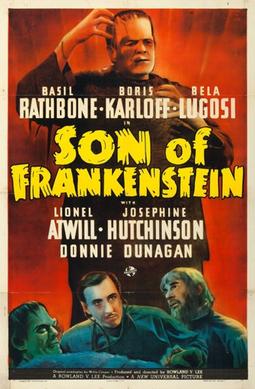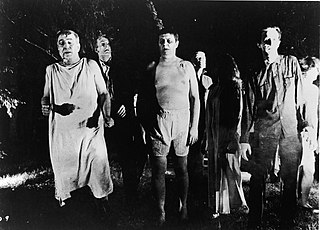
Béla Ferenc Dezső Blaskó, known professionally as Bela Lugosi, was a Hungarian–American actor, best remembered for portraying Count Dracula in the 1931 horror classic Dracula, Ygor in Son of Frankenstein (1939) and his roles in many other horror films from 1931 through 1956.

Bride of the Monster is a 1955 American science fiction horror film, co-written, produced and directed by Edward D. Wood Jr., and starring Bela Lugosi and Tor Johnson with a supporting cast featuring Tony McCoy and Loretta King.

Abbott and Costello Meet Frankenstein is a 1948 American horror comedy film directed by Charles Barton. The film features Count Dracula who has become partners with Dr. Sandra Mornay, as Dracula requires a "simple, pliable" brain to reactivate Frankenstein's monster. Dracula discovers that the "ideal" brain belongs to Wilbur Grey who is wooed by Mornay to the operating table, despite the warnings of Lawrence Talbot.

Creighton Tull Chaney, known by his stage name Lon Chaney Jr., was an American actor known for playing Larry Talbot in the film The Wolf Man (1941) and its various crossovers, Count Alucard in Son of Dracula, Frankenstein's monster in The Ghost of Frankenstein (1942), the Mummy in three pictures, and various other roles in many Universal horror films, making him a horror icon. He also portrayed Lennie Small in Of Mice and Men (1939) and supporting parts in dozens of mainstream movies, including High Noon (1952), and The Defiant Ones (1958).

Universal Pictures is an American film production and distribution company owned by Comcast through the NBCUniversal Film and Entertainment division of NBCUniversal, which is a wholly owned subsidiary of the aforementioned company.

Dracula is a 1931 American pre-Code supernatural horror film directed and co-produced by Tod Browning from a screenplay written by Garrett Fort and starring Bela Lugosi in the titular role. It is based on the 1924 stage play Dracula by Hamilton Deane and John L. Balderston, which in turn is adapted from the 1897 novel Dracula by Bram Stoker. Lugosi portrays Count Dracula, a vampire who emigrates from Transylvania to England and preys upon the blood of living victims, including a young man's fiancée.

Jack Pierce was a Hollywood make-up artist best remembered for creating the iconic makeup worn by Boris Karloff in Frankenstein (1931), along with various other classic monster make-ups for Universal Studios.

Producers Releasing Corporation was the smallest and least prestigious of the Hollywood film studios of the 1940s. It was considered a prime example of what was called "Poverty Row": a low-rent stretch of Gower Street in Hollywood where shoestring film producers based their operations. However, PRC was more substantial than the usual independent companies that made only a few low-budget movies and then disappeared. PRC was an actual Hollywood studio – albeit the smallest – with its own production facilities and distribution network, and it even accepted imports from the UK. PRC lasted from 1939 to 1947, churning out low-budget B movies for the lower half of a double bill or the upper half of a neighborhood theater showing second-run films. The studio was originally located at 1440 N. Gower St. from 1936 to 1943. PRC then occupied the former Grand National Pictures physical plant at 7324 Santa Monica Blvd., from 1943 to 1946. This address is now an apartment complex.

The Gorilla is a 1939 American horror comedy film starring the Ritz Brothers, Anita Louise, Art Miles, Lionel Atwill, Bela Lugosi, and Patsy Kelly. It was based on the 1925 play of the same name by Ralph Spence.

Herman Cohen was an American producer of B-movies during the 1950s, and helped to popularize the teen horror movie genre with films like the cult classic I Was a Teenage Werewolf.

Son of Frankenstein is a 1939 American horror film that was directed by Rowland V. Lee and stars Basil Rathbone, Boris Karloff and Bela Lugosi. The film is the third in Universal Pictures' Frankenstein series and is the follow-up to the 1935 film Bride of Frankenstein. Son of Frankenstein stars Rathbone as Baron Wolf von Frankenstein who, with his wife Elsa and son Peter, returns to his late father's estate. Near the castle lives Ygor, a crazed blacksmith whose neck was broken in an unsuccessful hanging attempt. Among the castle's remains, Frankenstein discovers the remains of the monster and decides to try to save his family name by resurrecting the creature to prove his father was correct. He finds, however, the monster only responds to Ygor's commands.

House of Dracula is a 1945 American horror film released and distributed by Universal Pictures. Directed by Erle C. Kenton, the film features several Universal Horror properties meeting as they had done in the 1944 film House of Frankenstein. The film is set at the castle home of Dr. Franz Edelmann, who is visited first by Count Dracula and later by Larry Talbot, the Wolf Man, who are trying to cure their vampirism and lycanthropy, respectively. Talbot is eventually cured, which leads him to discover the body of Frankenstein's monster in a cave below the base of the castle. Edelemann takes the monster's body back to his laboratory but finds Count Dracula has awakened and by attacking his assistants, he captures Edelmann and forces a reverse blood transfusion, which gives Edelmann a split personality and makes him a killer.

Bela Lugosi Meets a Brooklyn Gorilla is a 1952 American comedy horror science fiction film directed by William Beaudine and starring horror veteran Bela Lugosi with nightclub performers Duke Mitchell and Sammy Petrillo in roles approximating the then-popular duo of Martin and Lewis.

Sam Patrello was an American nightclub and movie comedian best known as a Jerry Lewis imitator.

Murders in the Rue Morgue is a 1932 American horror film directed by Robert Florey, based on Edgar Allan Poe's 1841 short story "The Murders in the Rue Morgue". The plot is about Doctor Mirakle, a carnival sideshow entertainer and scientist who kidnaps Parisian women to mix their blood with that of his gorilla, Erik. As his experiments fail because of the quality of his victims' blood, Mirakle meets with Camille L'Espanye, and has her kidnapped and her mother murdered, leading to suspicion falling on Camille's fiance, Pierre Dupin, a medical student who has already become interested in the earlier murders.
James Harvey Nicholson was an American film producer. He is best known as the co-founder, with Samuel Z. Arkoff, of American International Pictures.
The Bowery Boys are fictional New York City characters, portrayed by a company of New York actors, who were the subject of 48 feature films released by Monogram Pictures and its successor Allied Artists Pictures Corporation from 1946 through 1958.
Ted Okuda is an American non-fiction author and film historian. He has many books and magazine features to his credit, under his own name and in collaboration with others.

Man-Made Monster is a 1941 American science-fiction horror film directed by George Waggner and produced by Jack Bernhard for Universal Pictures. Filmed in black-and-white, it stars Lon Chaney Jr. and Lionel Atwill. Man-Made Monster was re-released under various titles including Electric Man and The Mysterious Dr. R. Realart Pictures re-released the film in 1953 under the title The Atomic Monster as a double feature with The Flying Saucer (1950). On the film's original main title, there is no hyphen; it's simply Man Made Monster.

The B movie, whose roots trace to the silent film era, was a significant contributor to Hollywood's Golden Age of the 1930s and 1940s. As the Hollywood studios made the transition to sound film in the late 1920s, many independent exhibitors began adopting a new programming format: the double feature. The popularity of the twin bill required the production of relatively short, inexpensive movies to occupy the bottom half of the program. The double feature was the predominant presentation model at American theaters throughout the Golden Age, and B movies constituted the majority of Hollywood production during the period.
















